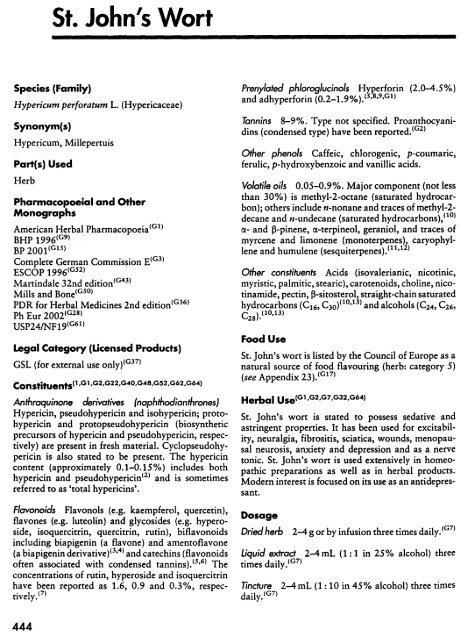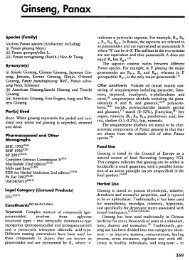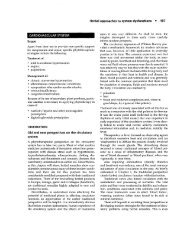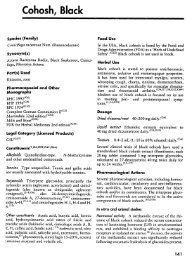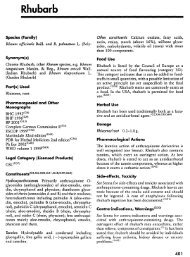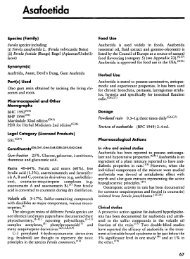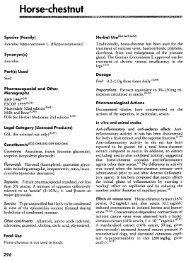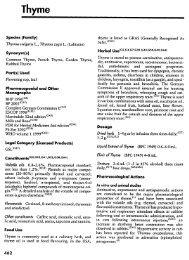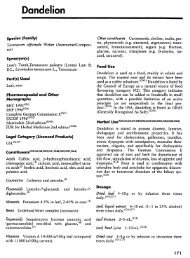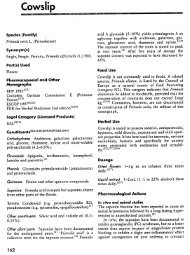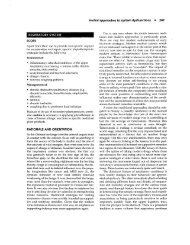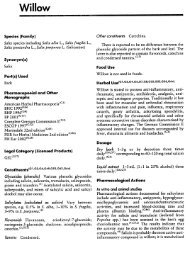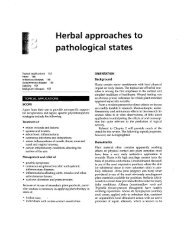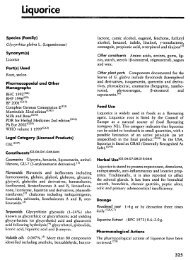St. John's Wort
St. John's Wort
St. John's Wort
You also want an ePaper? Increase the reach of your titles
YUMPU automatically turns print PDFs into web optimized ePapers that Google loves.
<strong>St</strong>. <strong>John's</strong> <strong>Wort</strong><br />
Species (Family)<br />
Hypericum perforatum L. (Hypericaceae)<br />
Synonym(s)<br />
Hypericum, Millepertuis<br />
Part(s) Used<br />
Herb<br />
Pharmacopoeial and Other<br />
Monographs<br />
American Herbal Pharmacopoeia (Gl)<br />
BHP 1996 (G9)<br />
BP 2001 (G15)<br />
Complete German Commission E (G3)<br />
ESCOP 1996 (G52)<br />
Martindale 32nd edition (G43)<br />
Mills and Bone (G50)<br />
PDR for Herbal Medicines 2nd edition (G36)<br />
Ph Eur 2002 (G21)<br />
USP24/NF19 (G61)<br />
Legal Category (Licensed Products)<br />
GSL (for external use only) (G37)<br />
Constituents(1,G 1,G2,G22,G40,G48,G52,G62,G64)<br />
Anthraquinone derivatives (naphthoclionthrones)<br />
Hypericin, pseudohypericin and isohypericin; protohypericin<br />
and protopseudohypericin (biosynthetic<br />
precursors of hypericin and pseudohypericin, respectively)<br />
are present in fresh material . Cyclopseudohypericin<br />
is also stated to be present . The hypericin<br />
content (approximately 0 .1-0 .15%) includes both<br />
hypericin and pseudohypericin (2) and is sometimes<br />
referred to as `total hypericins' .<br />
Flavonoids Flavonols (e .g . kaempferol, quercetin),<br />
flavones (e .g . luteolin) and glycosides (e.g . hyperoside,<br />
isoquercitrin, quercitrin, rutin), biflavonoids<br />
including biapigenin (a flavone) and amentoflavone<br />
(a biapigenin derivative ) ( 3,4) and catechins (flavonoids<br />
often associated with condensed tannins) . (5,6) The<br />
concentrations of rutin, hyperoside and isoquercitrin<br />
have been reported as 1 .6, 0 .9 and 0 .3%, respectively<br />
. (7)<br />
Prenylated phloroglucinols Hyperforin (2 .0-4 .5%)<br />
and adhyperforin (0 .2-1.9%) . (5,8,9,G1)<br />
Tannins 8-9% . Type not specified . Proanthocyanidins<br />
(condensed type) have been reported . (G2)<br />
Other phenols Caffeic, chlorogenic, p-coumaric,<br />
ferulic, p-hydroxybenzoic and vanillic acids .<br />
Volatile oils 0 .05-0.9% . Major component (not less<br />
than 30%) is methyl-2-octane (saturated hydrocarbon)<br />
; others include n-nonane and traces of methyl-2-<br />
decane and n-undecane (saturated hydrocarbons), (10)<br />
a- and (3-pinene, a-terpineol, geraniol, and traces of<br />
myrcene and limonene (monoterpenes), caryophyllene<br />
and humulene (sesquiterpenes) . (11,12)<br />
Other constituents Acids (isovalerianic, nicotinic,<br />
myristic, palmitic, stearic), carotenoids, choline, nicotinamide,<br />
pectin, (3-sitosterol, straight-chain saturated<br />
hydrocarbons (C16, C30)<br />
(1°,13) and alcohols (C24, C26,<br />
C28 ) . (10,13)<br />
Food Use<br />
<strong>St</strong> . <strong>John's</strong> wort is listed by the Council of Europe as a<br />
natural source of food flavouring (herb : category 5)<br />
(see Appendix 23) . (G17)<br />
Herbal Use (G1,G2,G7,G32,G64)<br />
<strong>St</strong> . <strong>John's</strong> wort is stated to possess sedative and<br />
astringent properties . It has been used for excitability,<br />
neuralgia, fibrositis, sciatica, wounds, menopausal<br />
neurosis, anxiety and depression and as a nerve<br />
tonic. <strong>St</strong> . <strong>John's</strong> wort is used extensively in homeopathic<br />
preparations as well as in herbal products .<br />
Modern interest is focused on its use as an antidepressant.<br />
Dosage<br />
(G7)<br />
Dried herb 2-4 g or by infusion three times daily .<br />
Liquid extract 2-4mL (1 :1 in 25% alcohol) three<br />
times daily . (G7)<br />
Tincture 2-4mL (1 :10 in 45% alcohol) three times<br />
daily . (G7)<br />
444
<strong>St</strong> . <strong>John's</strong> <strong>Wort</strong> 445<br />
The doses of <strong>St</strong> . <strong>John's</strong> wort extract used in clinical<br />
trials involvin 鋼 patients with mild to moderate depression<br />
鋼 enerally ran 鋼 e from 350 to 1800 m 鋼 daily<br />
(equivalent to 0 .4 to 2 .7 m 鋼 hypericin daily, dependin<br />
鋼 on the extract) . (14)<br />
Pharmacolo 鋼 ical Actions<br />
The major active constituents are considered to be<br />
hyperforin (a prenylated phloro 鋼 lucinol) and hypericin<br />
(a naphthodianthrone), althou 鋼 h other biolo 鋼 i-<br />
cally active constituents, e . 鋼 . flavonoids and tannins,<br />
are also present!" ) Several pharmacolo 鋼 ical activities,<br />
includin 鋼 antidepressant, antiviral and antibacterial<br />
effects, have been documented for extracts of <strong>St</strong> .<br />
<strong>John's</strong> wort and/or its constituents . The pharmacolo<br />
鋼 y and pharmacod namics of <strong>St</strong> . <strong>John's</strong> wort have<br />
been reviewed .( 1,16,G1,G50,G55)<br />
In vitro and animal studies<br />
Anticlepressont activity The precise mechanism of<br />
action for the antidepressant effect of <strong>St</strong> . <strong>John's</strong> wort<br />
is unclear . Initially, attention was focused on hypericin<br />
as the constituent of <strong>St</strong> . <strong>John's</strong> wort believed to be<br />
responsible for the herb's antidepressant effects . Inhibition<br />
of monoamine oxidase (MAO) type A and B in<br />
rat brain mitochondria in vitro was described for<br />
hypericin ." 7) However, other studies have demonstrated<br />
only weak or no MAO inhibition . (18-20)<br />
In vitro receptor bindin 鋼 and enzyme inhibition<br />
assays carried out usin 鋼 hypericum extract demonstrated<br />
si 鋼 nificant receptor affinity for adenosine,<br />
GABAA , GABAB , benzodiazepine and MAO types A<br />
and B, althou 鋼 h, with the exception of GABA A and<br />
GABAB , the concentrations of hypericum required<br />
were unlikely to be attained after oral administration<br />
in humans . (21) Other biochemical studies have<br />
reported that the hypericum extract LI 160 is only a<br />
weak inhibitor of MAO-A and MAO-B activity, but<br />
that it inhibits the synaptosomal uptake of serotonin<br />
(5-hydroxytryptamine or S-HT), dopamine and noradrenaline<br />
(norepinephrine) with approximately<br />
equal affinity and also leads to a downre 鋼 ulation of<br />
(3-receptors and an upre 鋼 ulation of 5-HT 2 receptors in<br />
the rat frontal cortex . (22 ~ The effects of fluoxetine and<br />
hypericin- and flavonoid-standardised hypericum<br />
extracts (LI 160, 0.3% hypericin and 6% flavonoids<br />
and Ph-50, 0 .3% hypericin and 50% flavonoids) on<br />
the concentrations of neurotransmitters in brain<br />
re 鋼 ions were studied in rats . (23' All three preparations<br />
induced a si 鋼 nificant increase in 5-HT concentrations<br />
in the rat cortex, both LI 160 and Ph-50 caused<br />
increases in noradrenaline (norepinephrine) and<br />
dopamine in the rat diencephalon and Ph-50 also<br />
induced an increase in the noradrenaline (norepi-<br />
nephrine) content in the brainstem, areas that are<br />
implicated in depression . (231 In studies usin 鋼 the rat<br />
forced swimmin 鋼 test, an experimental model of<br />
depression, hypericum extracts induced a si 鋼 nificant<br />
(24)<br />
reduction in immobility .<br />
Hyperforin has now emer 鋼 ed as bein 鋼 one of the<br />
major active constituents of importance in antidepressant<br />
activity . Hyperforin has been shown to be an<br />
uptake inhibitor of 5-HT, dopamine, noradrenaline<br />
(norepinephrine), GABA and L- 鋼 lutamate in synaptosomal<br />
preparations (25) and to inhibit 5-HT uptake in<br />
rat peritoneal cells in a dose-dependent manner . (26)<br />
<strong>St</strong>udies have also described discrepancies between<br />
observed and theoretical IC 50 values, indicatin 鋼 that<br />
hyperforin is not the only component of hypericum<br />
extract that is responsible for the observed<br />
effects . 126,27) It has been reported that the mode of<br />
action of hyperforin in serotonin uptake inhibition<br />
seems to be associated with the elevation of free<br />
intracellular sodium ion concentrations (28) and that<br />
this may be secondary to activation of the Na`/H*<br />
exchan 鋼 e as a result of a decrease in intracellular<br />
pH. (29) Hyperforin was shown to inhibit 5-HT reuptake<br />
in washed platelets but not in fresh platelet-rich<br />
plasma, su 鋼 鋼 estin 鋼 that plasma-protein bindin 鋼 could<br />
be a limitin 鋼 factor for 5-HT uptake inhibition in<br />
(30)<br />
vivo .<br />
A commercial extract of <strong>St</strong> . <strong>John's</strong> wort has exhibited<br />
psychotropic and antidepressant activities in<br />
mice . (31) Pure hyperforin and hypericum extracts<br />
also demonstrated antidepressant activity in a despair<br />
behaviour test in rats . (26)<br />
In other experimental models of depression,<br />
includin 鋼 acute and chronic forms of escape deficit<br />
induced by stressors, hypericum extract was shown to<br />
protect rats from the consequences of unavoidable<br />
stress . (32) Flavonoid fractions and flavonoids isolated<br />
from these fractions have been reported to have<br />
antidepressant activity in exerimental studies<br />
(forced swimmin 鋼 test) in rats . (33)<br />
Antimicrobiol activity A leaf extract has been documented<br />
as enhancin 鋼 the immunity of mice towards<br />
<strong>St</strong>aphylococcus aureus and Bordetella pertussis ; (34)<br />
hyperforin is reported to be antibacterial with activity<br />
a 鋼 ainst S. aureus . (8) Antibacterial activity of hyperforin<br />
a 鋼 ainst multiresistant S . aureus and Grampositive<br />
bacteria, includin 鋼 <strong>St</strong>reptococcus pyo 鋼 enes<br />
and Corynebacterium diphtheriae, has been<br />
reported . 05) However, it has been emphasised that<br />
the antibacterial effects of hyperforin are only<br />
observed at hi 鋼 h concentrations . (36,171 Hyperforin<br />
did not exhibit any 鋼 rowth inhibitory effect a 鋼 ainst<br />
Gram-ne 鋼 ative bacteria, such as Enterococcus faecalis,<br />
Escherichia coli and 1'seudomonas aeru 鋼 inosa or
446 <strong>St</strong> . <strong>John's</strong> ort<br />
against Candida albicans .j 31) Further antibiotic constituents<br />
have been isolated from <strong>St</strong> . <strong>John's</strong> wort :<br />
imanine and novoimanine . 138,39) Novoimanine was<br />
reported to be the most effective topical agent against<br />
S. aurcrrs .~ 18) Herb extracts are reported to exhibit<br />
more pronounced activity against staphylococci, shigellae<br />
and E. coli than are decoctions . (3Z40)<br />
Antiviral activity Flavonoid and catechin-containing<br />
fractions have exhibited antiviral activity, inhibiting<br />
the influenza virus by 83-100% . (41) Hypericin and<br />
pseudohypericin have been reported to inhibit several<br />
encapsulated viruses in vitro, including herpes simplex<br />
types 1 and 2(42,43) and human immunodeficiency<br />
virus type 1 (HI-1) . (44-47) Hypericin has also<br />
been reported to inactivate murine cytomegalovirus<br />
(MCM) and Sindbis virus . (47) he antiviral activity<br />
of hypericin appears to involve a photoactivation<br />
process . (47,Gl)<br />
Other effects In vitro studies using a hamster vas<br />
deferens smooth muscle cell line demonstrated that<br />
hyperforin induces the release of calcium ions from<br />
mitochondrial or other sources followed by activation<br />
of cellular metabolism . (48) It is not known whether<br />
this activity contributes to the antidepressant effects<br />
of hyperforin.<br />
Oral administration of a single dose of <strong>St</strong> . <strong>John's</strong><br />
wort (100, 200, 400, 600 or 800 mg/kg) to two strains<br />
of alcohol-preferring rats sinificantly reduced<br />
alcohol intake in both strains . (49) In another study in<br />
experimental alcoholism, acute intraperitoneal<br />
administration of <strong>St</strong> . <strong>John's</strong> wort (10-40 mg/kg),<br />
fluoxetine (1-10 mg/kg) and imipramine (3-30 mg/<br />
kg) reduced alcohol intake in a dose-dependent manner<br />
in a 12-hour, limited access, two-bottle choice<br />
(ethanowater) procedure . (24) Depression and alcoholism<br />
are thought to have some neurochemical<br />
similarities, such as low brain serotonin concentrations<br />
. (so)<br />
It has been suggested that biflavonoids may be the<br />
sedative principles in <strong>St</strong> . <strong>John's</strong> wort since CNS<br />
activity has been documented for biflavonoid constituents<br />
in another plant, axus baccata . (3)<br />
An extract of <strong>St</strong>. <strong>John's</strong> wort was found to suppress<br />
inflammation and leukocyte infiltration induced by<br />
carrageenan and prostaglandin E l (PGE 1 ) in mice . (51)<br />
In vitro, hypericin has been shown to inhibit tumour<br />
necrosis factor-induced activation of the transcription<br />
factor NF-1CB, (S2) specific growth factor-regulated<br />
protein kinases (53-55) and the release of arachidonic<br />
acid and leukotriene B4 . (56) In a rabbit model of<br />
proliferative vitreoretinopathy (PR), intravitreal<br />
injection of hypericin 0 .1 mL (10 or 100 pmol/L, but<br />
not 1 pmol/L) inhibited the progression of PR when<br />
compared with severity in control eyes five days after<br />
hypericin administration . (57) It was suggested that, as<br />
protein kinase C is important in the cellular reactions<br />
occurring in PR, modulation of protein kinase C by<br />
hypericin may be a factor in this system . Hypericin<br />
and pseudohypericin have been reported to inhibit 12-<br />
lipoxygenase activity ; the products of lipoxygenasecatalysed<br />
reactions, such as leukotrienes, may be<br />
involved in inflammatory reactions . (58)<br />
Other compounds may contribute to the antiinflammatory<br />
properties of <strong>St</strong> . <strong>John's</strong> wort . (37) Antiinflammatory<br />
and anti-ulcerogenic properties have<br />
been documented for amentoflavone, a biapigenin<br />
derivative . (4) Analgesic activity in mice has been<br />
reported for the total flavonoid fraction ; (59) the active<br />
principle was stated to be of the quercetin type .<br />
Both water-soluble imanine and imanine were<br />
reported to reduce blood pressure and increase the<br />
frequency and depth of breathing following intravenous<br />
administration (50 mg/kg) to rabbits . (3) A study<br />
of the vasoconstrictor action of water-soluble imanine<br />
and imanine on the isolated rabbit ear indicated that<br />
their hypotensive action was not due to a direct effect<br />
on the vasculature . (38) hen perfused through the<br />
isolated frog heart, both water-soluble imanine and<br />
imanine were found to cause cardiac systolic arrest<br />
at a dilution of 1 x 10 -5 . (38) Proanthocyanidin-containing<br />
fractions isolated from <strong>St</strong> . <strong>John's</strong> wort have<br />
been reported to inhibit contractions of the isolated<br />
guinea-pig heart induced by histamine, PGF 2 ,, and<br />
potassium chloride . (60)<br />
A tonus-raising effect on isolated guinea-pig and<br />
rabbit uteri has been documented for a crude aqueous<br />
extract . (") Of the group of plants investigated, <strong>St</strong> .<br />
<strong>John's</strong> wort was reported to exhibit the weakest<br />
uterotonic activity .<br />
annins isolated from <strong>St</strong>. <strong>John's</strong> wort are stated to<br />
have mild astringent activity . (62) he anthraquinone<br />
derivatives documented for <strong>St</strong> . <strong>John's</strong> wort do not<br />
possess any purgative action . (G62<br />
In vitro cytotoxicity against human colon carcinoma<br />
cells (CO 115) has been described for hyperforin-related<br />
constituents isolated from Hypericum<br />
calycinum and Hypericum revolutum . (63)<br />
Clinical studies<br />
Clinical trials with extracts of <strong>St</strong> . <strong>John's</strong> wort have<br />
focused mainly on its effects in patients with depression,<br />
although there have been several studies exploring<br />
its use in other conditions, including seasonal<br />
affective disorder, chronic fatigue and premenstrual<br />
syndrome .<br />
Depression Initially, hypericin was thought to be<br />
responsible for the antidepressant activity of <strong>St</strong> .
<strong>St</strong> . <strong>John's</strong> <strong>Wort</strong> 447<br />
<strong>John's</strong> wort, although, more recently, experimenta1<br />
125,26) and clinical evidence (64) has emerged to<br />
indicate that hyperforin is one of the major constituents<br />
required for antidepressant activity .<br />
The precise mechanism of action of <strong>St</strong> . <strong>John's</strong><br />
wort's antidepressant effect remains unclear (see<br />
Pharmacological Actions, In vitro and animal studies)<br />
. A double-blind, placebo-controlled, crossover<br />
study in 12 healthy male volunteers investigated the<br />
effects of a single dose of <strong>St</strong> . <strong>John's</strong> wort extract (LI<br />
160) (2700 mg, 9 x 300-mg tablets standardised to<br />
0 .3% hypericin) on plasma concentrations of growth<br />
hormone, prolactin and cortisol . (65) A significant<br />
increase in plasma growth hormone concentration<br />
and a significant decrease in plasma prolactin concentration<br />
were observed following <strong>St</strong>. <strong>John's</strong> wort<br />
administration relative to placebo administration .<br />
Plasma cortisol concentrations were unchanged .<br />
These findings suggest that this dose of Sr. <strong>John's</strong><br />
wort extract may increase aspects of brain dopamine<br />
function in humans, although further studies are<br />
required to confirm this, assess dose-response relationships<br />
and determine whether there is evidence for<br />
effects on dopaminergic systems in patients with<br />
depression treated with <strong>St</strong> . <strong>John's</strong> wort . (65) Another<br />
study, which used a randomised, three-way, crossover<br />
design, investigated the effects of a single dose of <strong>St</strong> .<br />
<strong>John's</strong> wort extract (LI 160S) (600 or 300 mg) or<br />
placebo on hormone concentrations in 12 healthy<br />
male volunteers . (66) Compared with placebo, <strong>St</strong> .<br />
<strong>John's</strong> wort extract (600 mg) increased cortisol secretion<br />
between 30 and 90 minutes after dosing, indicating<br />
an influence of <strong>St</strong> . <strong>John's</strong> wort on certain CNS<br />
neurotransmitters. There was no difference between<br />
the three groups with regard to adrenocorticotrophic<br />
hormone (ACTH), growth hormone and prolactin<br />
secretion . (66)<br />
A systematic review and meta-analysis of randomised<br />
controlled trials of preparations of <strong>St</strong> . <strong>John's</strong><br />
wort extract included 23 trials involving a total of<br />
1757 patients with depressive disorders .<br />
(67) This has<br />
been updated to include new studies and published as<br />
a Cochrane review of 27 randomised controlled trials<br />
of <strong>St</strong> . <strong>John's</strong> wort extract in patients with `neurotic<br />
depression' and mild to moderately severe depressive<br />
disorders . 14) Seventeen of these trials (involving 1168<br />
~<br />
patients) compared <strong>St</strong> . <strong>John's</strong> wort preparations with<br />
placebo (16 studies used preparations containing <strong>St</strong> .<br />
<strong>John's</strong> wort extract as the sole herbal ingredient and<br />
one involved a combination product of <strong>St</strong> . <strong>John's</strong> wort<br />
extract with four other herbal ingredients) ; the ten<br />
other trials (involving 1123 patients) compared <strong>St</strong> .<br />
<strong>John's</strong> wort extracts with conventional antidepressant<br />
or sedative drugs, including amitriptyline, imipramine,<br />
desipramine and maprotiline (eight trials used<br />
single-ingredient preparations and two used combinations<br />
of <strong>St</strong> . <strong>John's</strong> wort and valerian) . <strong>St</strong> . <strong>John's</strong> wort<br />
extracts were administered at doses ranging from 350<br />
to 1800 mg; the hyperforin content of the preparations<br />
tested was not known . Most trials lasted for 4-6<br />
weeks, although some studies were conducted for<br />
three months .<br />
The results of the meta-analysis showed that <strong>St</strong> .<br />
<strong>John's</strong> wort preparations were significantly superior<br />
to placebo in the short-term treatment of mild to<br />
moderately severe depressive disorders (rate ratio<br />
2.47 and 95% confidence interval (95% CI) 1 .69-<br />
3 .61) . <strong>St</strong> . <strong>John's</strong> wort preparations were found to be as<br />
effective as conventional antidepressant agents (single<br />
preparations, rate ratio 1 .01 and 95% CI 0 .87-1 .16),<br />
although for several reasons - for example, the use of<br />
low doses of conventional antidepressants and the<br />
trials involving small numbers of patients - this<br />
evidence was considered inadequate for establishing<br />
whether <strong>St</strong> . <strong>John's</strong> wort was as effective as conventional<br />
antidepressant drugs ."' ) Further studies comparing<br />
<strong>St</strong>. <strong>John's</strong> wort preparations with standard<br />
antidepressant agents in well-defined patient groups<br />
and over longer periods were considered necessary<br />
. 141 .<br />
Another meta-analysis employed tighter inclusion<br />
criteria for trials in an effort to increase the validity of<br />
the analysis .<br />
(68) It included only randomised, blinded,<br />
controlled trials of <strong>St</strong> . <strong>John's</strong> wort as a single preparation,<br />
which involved patients with depressive disorders<br />
as defined by the standard criteria ICD-10<br />
(International <strong>St</strong>atistical Classification of Diseases<br />
and Related Health Problems), DSM-IIIR (Diagnosstical<br />
Manual) or DSM-IV and which used the Hamilton<br />
Depression (HAMD) Scale for measuring clinical<br />
outcomes . Six such trials involving 651 patients with<br />
mainly mild to moderately severe depressive disorders<br />
were included ; two trials were placebo controlled and<br />
four compared <strong>St</strong> . <strong>John's</strong> wort with standard antidepressants<br />
. The studies lasted for 4-6 weeks and the<br />
doses of <strong>St</strong> . <strong>John's</strong> wort extract ranged from 200 to<br />
900 mg daily ; the range for total hypericin administered<br />
was 0 .75-2 .7 mg daily .<br />
This meta-analysis showed that the response rate<br />
for <strong>St</strong> . <strong>John's</strong> wort was significantly greater than that<br />
for placebo (73 .2 versus 37.9%, respectively, relative<br />
risk 1 .48 and 95% CI 1 .03-1 .92) and similar to that<br />
observed with tricyclic antidepressants (64 versus<br />
6.4% for <strong>St</strong> . <strong>John's</strong> wort and tricyclic antidepressants,<br />
respectively, relative risk 1 .11 and 95% Cl<br />
0 .92-1 .29) . (611) Despite the stringent inclusion criteria<br />
for trials in this meta-analysis, it was concluded<br />
that further studies are required in order to address<br />
methodological problems before it can be concluded<br />
that <strong>St</strong>. <strong>John's</strong> wort is an effective antidepressant . (68)
448 <strong>St</strong> . <strong>John's</strong> <strong>Wort</strong><br />
At least four randomised, controlled trials of<br />
monopreparations of <strong>St</strong> . <strong>John's</strong> wort involving<br />
patients with depressive disorders (64,69-71) have been<br />
published since the Cochrane review . (14) Two trials<br />
compared <strong>St</strong>. <strong>John's</strong> wort against placebo only, (64,69)<br />
one compared <strong>St</strong> . <strong>John's</strong> wort with fluoxetine (70) and<br />
one was a three-arm study comparing <strong>St</strong> . <strong>John's</strong> wort<br />
with imipramine and placebo . 1)<br />
In a randomised, double-blind, multicentre study,<br />
162 patients with mild to moderate depression<br />
received <strong>St</strong> . <strong>John's</strong> wort extract (ZE117) (250mg)<br />
twice daily (equivalent to 1 mg hypericin daily) or<br />
placebo for six weeks . (69) At the end of the study,<br />
56% of <strong>St</strong> . <strong>John's</strong> wort-treated patients compared<br />
with 15% of placebo recipients were classified as<br />
responders according to recognised criteria . The proportions<br />
of patients reporting adverse events were<br />
similar between groups (7.4 and 6 .2% for <strong>St</strong> . <strong>John's</strong><br />
wort and placebo, respectively) .<br />
Another randomised, double-blind, multicentre<br />
trial compared two different extracts of <strong>St</strong> . <strong>John's</strong><br />
wort with placebo in 147 patients with mild or<br />
moderate depression according to DSM-IV criteria.<br />
(64) Patients received <strong>St</strong>. <strong>John's</strong> wort extract<br />
(300mg, WS 5573, containing 0 .5% hyperforin or<br />
300 mg, WS 5572, containing 5% hyperforin) or<br />
placebo three times daily for six weeks . Patients who<br />
received the extract containing 5% hyperforin<br />
showed the largest reduction in Hamilton Rating<br />
Scale for Depression scores from baseline values .<br />
Furthermore, 49% of these patients were classified<br />
as treatment responders (according to recognised<br />
criteria), whereas 38 .8 and 32 .7% of patients who<br />
received 0 .5% hyperforin and placebo recipients,<br />
respectively, were classified as responders . The proportions<br />
of patients reporting adverse events were<br />
similar (28 .6 versus 28 .6 versus 30.6% for 5% hyperforin,<br />
0 .5% hyperforin and placebo, respectively) .<br />
These findings were the first to show that the therapeutic<br />
effect of <strong>St</strong>. <strong>John's</strong> wort in mild to moderate<br />
depression depends on its hyperforin content . (64)<br />
In a study comparing <strong>St</strong> . <strong>John's</strong> wort with a<br />
selective serotonin reuptake inhibitor, 161 patients<br />
aged 60-80 years with mild or moderate depression<br />
according to ICD-10 criteria were randomised to<br />
receive <strong>St</strong> . <strong>John's</strong> wort extract (LoHyp-57) (400 mg)<br />
twice daily or fluoxetine (10mg) twice daily for six<br />
weeks. (70) Neither the hypericin nor the hyperforin<br />
content of the <strong>St</strong> . <strong>John's</strong> wort extract were stated in a<br />
published report of the study. At the end of the<br />
treatment period, 71 .4% of <strong>St</strong> . <strong>John's</strong> wort recipients<br />
and 72 .2% of fluoxetine recipients were classified as<br />
responders according to recognised, pre-defined criteria<br />
. Similar efficacy for both <strong>St</strong>. <strong>John's</strong> wort and<br />
fluoxetine was demonstrated when data from subgroups<br />
of patients with mild and moderate depression<br />
were analysed. The numbers of patients developing<br />
adverse reactions with a possible or probable relationship<br />
to treatment were 12 and 17 for <strong>St</strong>. <strong>John's</strong> wort<br />
and fluoxetine, respectively, leading to cessation of<br />
treatment in six and eight cases, respectively . (70)<br />
In a randomised, double-blind, multicentre trial in<br />
a primary care setting, 263 patients with moderate<br />
depression received <strong>St</strong> . <strong>John's</strong> wort extract (350 mg)<br />
three times daily (STEI 300, containing 0 .2-0 .3%<br />
hypericin and 2-3% hyperforin, n=106), imipramine<br />
(100 mg) daily (in three divided doses of 50, 25<br />
and 25 mg, titrated from 50 mg on day 1 and 75 mg on<br />
days 2-4, n=110) or placebo (n=47) for eight<br />
weeks . (71) Hypericum was found to be more effective<br />
than placebo after six weeks of treatment and to be as<br />
efficacious as imipramine after 8 weeks of treatment .<br />
In addition, both <strong>St</strong> . <strong>John's</strong> wort and imipramine were<br />
shown to improve quality of life, as measured by the<br />
SF-36, to a greater extent than placebo . Adverse<br />
events were reported by 22% of <strong>St</strong> . <strong>John's</strong> wort<br />
recipients, 46% of imipramine recipients and 19%<br />
of placebo recipients .<br />
This study was criticised for its use of a relatively<br />
low dose of imipramine, such that the trial shows only<br />
that a comparatively high dose of <strong>St</strong> . <strong>John's</strong> wort<br />
seems to be as effective as a comparatively low dose<br />
of imipramine . (72) Nevertheless, this (71) and other new<br />
trials( 4,69) have confirmed that <strong>St</strong> . <strong>John's</strong> wort<br />
extracts are more effective than placebo in mild to<br />
moderately severe depression . (72) However, further<br />
trials comparing <strong>St</strong> . <strong>John's</strong> wort with standard antidepressants,<br />
particularly newer classes of agents such<br />
as the selective serotonin reuptake inhibitors, are still<br />
required . A large placebo-controlled trial comparing<br />
<strong>St</strong> . <strong>John's</strong> wort extract (900-1800 mg daily) with the<br />
selective serotonin reuptake inhibitor sertraline (50-<br />
150 mg daily) in patients with major depression<br />
accordin - to DSM-IV criteria is ongoing in the United<br />
<strong>St</strong>ates . (73 Published abstracts of randomised, doubleblind,<br />
controlled trials have reported superiority of <strong>St</strong> .<br />
<strong>John's</strong> wort extract over placebo (74) and equivalent<br />
efficacy between <strong>St</strong> . <strong>John's</strong> wort and fluoxetine<br />
(20mg) daily in mild to moderate depression (75,76)<br />
and between <strong>St</strong>. <strong>John's</strong> wort and imipramine (150 mg)<br />
daily. (76)<br />
In a dose-ranging trial involving 348 patients with<br />
mild to moderate depression according to ICD-10<br />
criteria, patients were randomised to receive <strong>St</strong> .<br />
<strong>John's</strong> wort extract three times daily equivalent to<br />
either l mg (n=119), 0 .33 mg (n=115) or 0 .17 mg<br />
(n = 114) hypericin for six weeks . (77) At the end of the<br />
treatment period, there was a significant reduction in<br />
HAMD scores compared with baseline values . The<br />
response rates (according to recognised criteria) were
<strong>St</strong> . <strong>John's</strong> <strong>Wort</strong> 449<br />
68, 65 and 62% for 1, 0 .33 and 0 .17mg hypericin,<br />
respectively; the differences between groups were not<br />
statistically significant . Thus, the study showed that<br />
there was no dose-dependent effect of hypericin in <strong>St</strong> .<br />
<strong>John's</strong> wort extracts .<br />
Seasonal affective disorder The effects of <strong>St</strong> . <strong>John's</strong><br />
wort extracts have been investigated in studies involving<br />
subjects with seasonal affective disorder<br />
(SAD),(78, 9> although as yet there have not been any<br />
trials that have included a placebo control group .<br />
Twenty individuals with SAD were randomised to<br />
receive <strong>St</strong>. <strong>John's</strong> wort (LI 160) (300 mg) three times<br />
daily (equivalent to 0 .9 mg hypericin) with or without<br />
bright light therapy . (78) After four weeks, there were<br />
significant reductions in HAMD scores in both groups<br />
compared with baseline values and there were no<br />
statistically significant differences between groups .<br />
Another study evaluated data from individuals with<br />
mild to moderate SAD who had used <strong>St</strong> . <strong>John's</strong> wort<br />
(300 mg) three times daily (equivalent to 0 .9 mg<br />
hypericin) with (n=133) or without light therapy<br />
(n = 168) for eight weeks . (79) The study was not<br />
randomised and involved data collection by postal<br />
questionnaires . Data from 301 returned questionnaires<br />
were suitable for analysis . Significant reductions<br />
in the mean SAD scores were observed in both<br />
groups compared with baseline values ; the differences<br />
in the SAD scores between groups were statistically<br />
non-significant .<br />
Antiviral activity Antiviral activity has been reported<br />
for hypericin against human immunodeficiency virus<br />
(HIV) and hepatitis c .(80,81,82,) Several uncontrolled<br />
studies in HIV-positive patients who received <strong>St</strong> .<br />
<strong>John's</strong> wort extract have reported immunologic and<br />
clinical benefits, including increases in CD4 cell<br />
counts in some patients . 3'84) In a phase I, doseescalating<br />
study, 30 HIV-positive patients with CD4<br />
cell counts < 350 cells/mm 3 received intravenous synthetic<br />
hypericin twice weekly (0 .25 or 0 .5 mg/kg<br />
body-weight), three times weekly (0 .25 mg/kg) or<br />
oral hypericin daily (0 .5 mg/kg) . (85) Sixteen patients<br />
discontinued treatment early because of toxic effects,<br />
and phototoxicity in several other patients prevented<br />
completion of dose escalation . Antiretroviral activity<br />
as assessed by significant changes in HIV p24 antigen<br />
level, HIV titre, HIV RNA copies and CD4 cell counts<br />
was not observed .<br />
Other studies The potential for the use of <strong>St</strong> . <strong>John's</strong><br />
wort in 20 individuals presenting with fatigues 6) and<br />
in 19 women with self-reported premenstrual syndrorne<br />
(87 ~ has also been explored in uncontrolled<br />
pilot studies . Significant improvements in perceived<br />
fatigue and in symptoms of depression and anxiety<br />
were seen after six weeks' treatment with <strong>St</strong> . <strong>John's</strong><br />
wort (equivalent to 0 .9 mg hypericin daily) compared<br />
with baseline values (86) and in overall premenstrual<br />
syndrome scores after treatment with <strong>St</strong> . <strong>John's</strong> wort<br />
(equivalent to 0 .9 mg hypericin daily) for two menstrual<br />
cycles . (87) Thus, there is scope for conducting<br />
randomised controlled trials of <strong>St</strong> . <strong>John's</strong> wort in these<br />
conditions . (86,87)<br />
In a randomised, double-blind, placebo-controlled<br />
trial, 179 women with menopause-related psychovegetative<br />
symptoms received a combination preparation<br />
of <strong>St</strong>. <strong>John's</strong> wort and black cohosh (Cimicifuga<br />
racemosa) or placebo for six weeks . (88) The results<br />
indicated that the combination product had a significantly<br />
greater effect on the symptoms than did placebo.<br />
Postmarketing surveillance studies have been<br />
carried out with extracts of <strong>St</strong>. <strong>John's</strong> wort in patients<br />
with psychovegetative disorders (89) and in women<br />
with menopausal symptoms of psychological origin<br />
(90) (see Side-effects, Toxicity) . Improvements in<br />
symptom scores compared with baseline values following<br />
treatment with <strong>St</strong> . <strong>John's</strong> wort extracts were<br />
reported in all studies; these studies did not involve a<br />
control group .<br />
A randomised, double-blind, phase I study involving<br />
55 healthy volunteers who received <strong>St</strong> . <strong>John's</strong><br />
wort (900 mg) daily (containing 0 .5% hyperforin), <strong>St</strong> .<br />
<strong>John's</strong> wort (900 mg) daily (containing 5 .0% hyperforin)<br />
or placebo for eight days investigated the effects<br />
on quantitative electroencephalogram as an indicator<br />
of drug-induced pharmacological action . (91) Reproducible<br />
central pharmacodynamic effects were apparent<br />
in both groups of <strong>St</strong> . <strong>John's</strong> wort recipients<br />
compared with placebo recipients . The effects were<br />
greater in subjects who received extract containing<br />
5 .0% hyperforin than in those who received extract<br />
containing 0 .5% hyperforin .<br />
Placebo-controlled, crossover studies investigating<br />
the effects of <strong>St</strong> . <strong>John's</strong> wort (0.9 and 1 .8 mg) on the<br />
sleep polysomnogram of healthy subjects reported<br />
that both doses of <strong>St</strong> . <strong>John's</strong> wort significantly<br />
increased rapid eye movement (REM) sleep latency<br />
compared with placebo, but had no effect on REM<br />
sleep duration or other parameters of sleep architecture<br />
. (92)<br />
In a randomised, double-blind, placebo-controlled<br />
trial involving 23 overweight but otherwise healthy<br />
adults, subjects who received treatment with <strong>St</strong> .<br />
<strong>John's</strong> wort (900 mg) daily, Citrus aurantium extract<br />
(975 mg) daily and caffeine (528 mg) daily lost significantly<br />
more body weight than did subjects in the<br />
placebo and no-treatment control groups . (93)<br />
A placebo-controlled, crossover study in 19<br />
healthy volunteers who received <strong>St</strong> . <strong>John's</strong> wort for
450 <strong>St</strong> . <strong>John's</strong> <strong>Wort</strong><br />
15 days either alone or in combination with ethanol<br />
(to achieve a blood alcohol concentration of 0 .05%)<br />
reported that there were no differences between the<br />
two groups in sense of well-being or adverse events .<br />
(94)<br />
A randomised, double-blind, placebo-controlled,<br />
six-week trial involving 72 long-distance runners and<br />
triathletes reported significant improvements in<br />
endurance capacity in subjects who received vitamin<br />
E with <strong>St</strong> . <strong>John's</strong> wort compared with subjects who<br />
received vitamin E alone or placebo . (95)<br />
Pharmacokinetics Detailed pharmacokinetic studies<br />
have been carried out with the hypericin-standardised<br />
<strong>St</strong> . <strong>John's</strong> wort extract LI 160 . (96) Administration of<br />
single oral doses of LI 160 (300, 900 and 1800 mg) to<br />
healthy male volunteers resulted in peak plasma<br />
hypericin concentrations of 1 .5, 7 .5 and 14 .2 ng/mL<br />
for the three doses, respectively . Peak plasma concentrations<br />
were seen with hypericin after 2 .0-2 .6 hours<br />
and with pseudohypericin after 0.4-0 .6 hours . The<br />
elimination half-life of hypericin was between 24 .8<br />
and 26 .5 hours . Repeated doses of LI 160 (300 mg)<br />
three times daily resulted in steady-state concentrations<br />
after four days . (96) Oral administration of the <strong>St</strong> .<br />
<strong>John's</strong> wort extract WS 5572 (300 mg, equivalent to<br />
14 .8 mg hyperforin) resulted in peak plasma concentrations<br />
of 150 ng/mL being reached 3 .5 hours after<br />
administration . ~ 9) The elimination half-life was 9<br />
hours . Following repeated doses of 300 mg three<br />
times daily, the estimated steady-state plasma hyperforin<br />
concentrations were 100 ng/mL . Other studies<br />
investigating the pharmacokinetics of hypericum and<br />
hypericin have been summarised . (1,G1)<br />
Side-effects, Toxicity<br />
A review of safety data for <strong>St</strong> . <strong>John's</strong> wort obtained<br />
from reports of randomised controlled trials, drug<br />
monitoring and postmarketing surveillance studies<br />
(98-101) and national and international drug<br />
safety monitoring bodies has been published . (lo2)<br />
Collectively, the data indicate that <strong>St</strong> . <strong>John's</strong> wort is<br />
well-tolerated . Adverse effects are generally mild ; the<br />
most common adverse effects reported are gastrointestinal<br />
symptoms, dizziness, confusion and tiredness/<br />
sedation . In placebo-controlled trials, the frequency of<br />
adverse effects with <strong>St</strong>. <strong>John's</strong> wort is similar to that<br />
for placebo . (102) Photosensitivity appears to be an<br />
extremely rare event with recommended doses of <strong>St</strong> .<br />
<strong>John's</strong> won (see below) ' (<br />
102)<br />
Several postmarketing surveillance studies of the<br />
<strong>St</strong> . <strong>John's</strong> wort extracts HYP811, (89,103) LI 160 (90,104)<br />
and Neuroplant (105) have since been published . These<br />
studies provide further confirmation of the tolerability<br />
of <strong>St</strong> . <strong>John's</strong> wort extracts taken at recommended<br />
doses for short-term treatment (usually 4-6 weeks,<br />
althmh one study monitored 111 women for 12<br />
weeks ( 0) ) . The frequency of adverse reactions in<br />
6382 patients with mild depression who took <strong>St</strong> .<br />
<strong>John's</strong> wort for six weeks was reported to be<br />
0.125% (mainly skin reactions) . ( ' 0-5)<br />
A systematic review and meta-analysis of randomised<br />
controlled trials of <strong>St</strong> . <strong>John's</strong> wort in patients<br />
with mild to moderately severe depressive disorders<br />
reported that, in the trials comparing <strong>St</strong> . <strong>John's</strong> wort<br />
with standard antidepressants, the proportions of<br />
patients reporting side-effects were 26 .3 and 44.7%,<br />
respectively (rate ratio 0 .57 and 95% CI 0 .4-0 .69) . (14)<br />
However, further studies investigating the long-term<br />
safety of <strong>St</strong> . <strong>John's</strong> wort were advised . Another metaanalysis<br />
which employed tighter inclusion criteria<br />
reported that tricyclic antidepressants were associated<br />
with a higher proportion of side-effects than<br />
were <strong>St</strong> . <strong>John's</strong> wort preparations (47 versus 26.4%,<br />
respectively, relative risk 1 .72 and 95% CI 1 .30-<br />
2 .14) . (68) Randomised controlled trials<br />
(64 ' 69-71)<br />
published since the Cochrane meta-analysis (14) and<br />
published abstracts (74-76) have also reported that <strong>St</strong> .<br />
<strong>John's</strong> wort has a more favourable short-term safety<br />
profile than standard antidepressants (70,71,75,76) and<br />
that the frequency of adverse events seen with <strong>St</strong> .<br />
<strong>John's</strong> wort is similar to that for placebo (64,69,71,74)<br />
(see Clinical studies) . In a comparative trial of <strong>St</strong> .<br />
<strong>John's</strong> wort and fluoxetine, the frequency of adverse<br />
reactions associated with <strong>St</strong> . <strong>John's</strong> wort was higher<br />
than expected, although it was stated that the effects<br />
reported were similar to those known to occur with<br />
fluoxetine . (70) The observation that the frequency of<br />
adverse effects is lower in placebo-controlled trials of<br />
<strong>St</strong> . <strong>John's</strong> wort than in comparative trials with standard<br />
antidepressants has been made previously . (102) A<br />
review has attempted to compare the safety profile of<br />
<strong>St</strong> . <strong>John's</strong> wort systematically with that of several<br />
conventional antidepressants . (106)<br />
Photosensitivity Sensitivity to sunlight following the<br />
ingestion of hypericum or hypericin is known as<br />
hypericism .<br />
Delayed hypersensitivity or photodermatitis has<br />
been documented for <strong>St</strong> . <strong>John's</strong> wort following the<br />
ingestion of a herbal tea made from the leaves . (107)<br />
Hypericin is stated to be the photosensitising agent<br />
present in <strong>St</strong> . <strong>John's</strong> wort . (82,G33,G47) A review of the<br />
photodynamic actions of hypericin has been<br />
lished .( pub-<br />
08) In a double-blind, crossover, single-dose<br />
study in 13 healthy volunteers who received placebo<br />
or <strong>St</strong> . <strong>John's</strong> wort extract (LI 160) (900, 1800 and<br />
3600 mg containing 0, 2.81, 5 .62 and 11 .25 mg total<br />
hypericin, respectively), no evidence of photosensitivity<br />
was observed with or without <strong>St</strong> . <strong>John's</strong> wort
<strong>St</strong> . <strong>John's</strong> <strong>Wort</strong> 451<br />
following skin irradiation with both UV-A and UV-B<br />
light 4 hours after dosing . i09) In a multiple-dose study<br />
in which 50 volunteers received <strong>St</strong> . <strong>John's</strong> wort (LI<br />
160) (600 mg) three times daily (equivalent to 5 .6 mg<br />
total hypericin daily) for 15 days, a moderate increase<br />
in UV-A sensitivity was observed . (109) However, the<br />
doses used were higher than those recommended<br />
therapeutically . In another single-dose study, administration<br />
of <strong>St</strong> . <strong>John's</strong> wort (LI 160) (1800 mg, equivalent<br />
to 5 .4 mg total hypericin) to 12 healthy volunteers<br />
resulted in a mean serum total hypericin concentration<br />
of 43 ng/mL and a mean skin blister fluid concentration<br />
of 5 .3 ng/mL . (110) After administration of<br />
<strong>St</strong>. <strong>John's</strong> wort (300 mg) three times daily for seven<br />
days in order to achieve steady-state concentrations,<br />
the mean serum total hypericin concentration was<br />
12 .5 ng/mL and the mean skin blister fluid concentration<br />
was 2 .8 ng/mL; these concentrations are below<br />
those estimated to be phototoxic (> 100 ng/mL) .(' 10)<br />
The consumption of large quantities of <strong>St</strong>. <strong>John's</strong><br />
wort by grazing animals has been associated with the<br />
(11 1,G22,G5 1)<br />
development of photosensitivity . Mice<br />
given 0 .2-0 .5 mg of the herb were found to develop<br />
severe photodynamic effects . (G22) <strong>St</strong>udies using cell<br />
cultures of human keratinocytes incubated with<br />
hypericin or <strong>St</strong> . <strong>John's</strong> wort extract and exposed to<br />
UV-A resulted in a reduction in the LC S0 (lethal<br />
concentration) with h pericin, but only a mild reduction<br />
with hypericum . (112) From these findings it has<br />
been estimated that at least 30 times the therapeutic<br />
dose would be necessary to produce phototoxic effects<br />
in humans ." 12) Experimental evidence has suggested<br />
that a solution of hypericin can react with visible and<br />
UV light to produce free radical species and that this<br />
may lead to damage of proteins in the lens of the<br />
eye . 013j There are no reports of cataract formation in<br />
individuals who have taken <strong>St</strong> . <strong>John's</strong> wort .<br />
A study reported that HIV-positive patients treated<br />
with oral hypericin (0 .05 mglkg) for 28 days developed<br />
mild symptoms of photosensitivity on exposure<br />
to sunlight and that two patients developed intolerable<br />
symptoms of photosensitivity when the dose was<br />
increased to 0 .16 mg/kg . (114) In a dose-escalating<br />
study involving 30 HIV-infected patients treated<br />
with oral (0 .5 mg/kg daily) or intravenous hypericin<br />
(starting dosage 0 .25 mg/kg twice or three times<br />
weekly), 16 patients discontinued treatment before<br />
completing eight weeks of therapy because of moderate<br />
or severe phototoxicity ; severe cutaneous phototoxicity<br />
was observed in 11 out of 23 evaluable<br />
patients . (85) Other serious clinical or laboratory<br />
adverse events were infrequent : elevation of alkaline<br />
phosphatase and hepatic aminotransferase concentrations<br />
to more than five times normal values was noted<br />
in two and three patients, respectively .<br />
Other effects In humans A case of subacute toxic<br />
neuropathy possibly related to the use of <strong>St</strong> . <strong>John's</strong><br />
wort and subsequent exposure to sunlight has been<br />
reported ." 15) A woman developed stinging pains in<br />
areas exposed to the sun (face and hands) four weeks<br />
after starting treatment with <strong>St</strong> . <strong>John's</strong> wort (500 mg/<br />
day, extract and hypericin content not stated) ; the<br />
report did not state whether the woman was using any<br />
other products . Her symptoms improved three weeks<br />
after stopping <strong>St</strong>. <strong>John's</strong> wort and disappeared over<br />
the next two months .<br />
There have been reports of sensory nerve hypersensitivity<br />
occurring in individuals who have taken <strong>St</strong> .<br />
<strong>John's</strong> wort preparations (tablets or tinctures) .(' 16)<br />
Cases of mania (117,118) and hypomania (119,120)<br />
have been reported in individuals taking <strong>St</strong> . <strong>John's</strong><br />
wort preparations . Two cases of mania were reported<br />
in patients with bipolar depression who began selftreatment<br />
with standardised <strong>St</strong>. <strong>John's</strong> wort extract<br />
(900 mg) daily (118) and one in a patient experiencing<br />
a moderate depressive episode who was taking<br />
both sertraline and <strong>St</strong> . <strong>John's</strong> wort (dosage not<br />
known) ." 17) A case of hypomania was reported in a<br />
woman with panic disorder and unipolar major<br />
depression who had discontinued sertraline treatment<br />
one week before starting <strong>St</strong> . <strong>John's</strong> wort tincture<br />
." 19) Two cases of hypomania were reported in<br />
individuals with no history of bipolar disorder . (120) A<br />
man who had received electroconvulsive therapy and<br />
who had previously taken various antidepressant<br />
drugs, including venlafaxine, fluvoxamine, moclobemide<br />
and nortriptyline, experienced a hypomanic<br />
episode six weeks after starting <strong>St</strong> . <strong>John's</strong> wort<br />
(dosage not stated). A man with symptoms of posttraumatic<br />
stress disorder was diagnosed with an acute<br />
manic episode after three months of self-treatment<br />
with <strong>St</strong> . <strong>John's</strong> wort (dosage not stated) . (120)<br />
Several of these reports stated that the symptoms<br />
had resolved after stopping treatment with <strong>St</strong> . <strong>John's</strong><br />
wort, although in one case the patient improved but<br />
remained agitated despite cessation of <strong>St</strong> . <strong>John's</strong><br />
wort . (120) None of the cases involved rechallenge<br />
with <strong>St</strong> . <strong>John's</strong> wort and, in all cases, there were<br />
other pharmacological factors and/or underlying illnesses<br />
that could have been responsible for or contributed<br />
to the precipitation of mania .<br />
In animals and in vitro studies Experimental studies<br />
investigating the genotoxic potential and mutagenic<br />
activity of <strong>St</strong> . <strong>John's</strong> wort extracts in vitro and in vivo<br />
have been summarised .' G1,cs21 In vivo studies and<br />
most in vitro studies provided negative results, indicating<br />
a lack of mutagenic potential with defined<br />
<strong>St</strong> . <strong>John's</strong> wort extracts .' ) Mutagenic activity<br />
observed in an in vitro Ames test was attributed to
452 <strong>St</strong> . <strong>John's</strong> <strong>Wort</strong><br />
the presence of quercetin, although other studies have<br />
found no mutagenic potential with a <strong>St</strong> . <strong>John's</strong> wort<br />
extract and it has been stated that there is no valid<br />
evidence for the carcinogenicity of quercetin in<br />
humans . (GI,G52)<br />
Dietary administration of <strong>St</strong> . <strong>John's</strong> wort to rats<br />
was found to have no affect on various hepatic drugmetabolising<br />
enzymes (e .g. aminopyrine, N-<br />
demethylase, glutathione S-transferase and epoxide<br />
hydrolase) or on coper concentrations in the liver<br />
(see Contra-indications, Warnings, Drug interactions)<br />
. No major effects were observed on hepatic<br />
iron or zinc concentrations and no significant tisue<br />
lesions were found in four rats fed <strong>St</strong> . <strong>John's</strong> wort in<br />
their daily diet for 119 days (10% for first 12 days and<br />
5% thereafter because of unpalatability) . (121)<br />
Cytotoxic constituents related to hyperforin have<br />
been isolated from two related Hypericum species (see<br />
In vitro and animal studies) .<br />
Contra-indications, Warnings<br />
Individuals with sensitivity towards <strong>St</strong> . <strong>John's</strong> wort<br />
may experience allergic reactions . The use of <strong>St</strong>.<br />
<strong>John's</strong> wort is not advised in known cases of photosensitivity<br />
and, in view of the potential of hypericin as<br />
a photosensitising agent, therapeutic UV treatment<br />
should be avoided whilst using <strong>St</strong>. <strong>John's</strong> wort . (Gl)<br />
It has previously been suggested that excesive<br />
doses of <strong>St</strong>. <strong>John's</strong> wort mayotentiate monoamine<br />
oxidase inhibitor therapy . ("" However, as monoamine<br />
oxidase inhibitory activity has not been<br />
reported in vivo with <strong>St</strong> . <strong>John's</strong> wort, this warning is<br />
no longer considered necesary . In addition, avoidance<br />
of foodstuffs, such as those containing tyramine<br />
(e .g . cheese, wine, meat and yeast extracts) and<br />
medicines containing sympathomimetic agents (e .g.<br />
cough/cold remedies), which interact with MAOIs, is<br />
not considered necesary .<br />
Drug interactions Recent evidence has emerged<br />
from spontaneous reports(123) and published case<br />
reports(124-127) of interactions between <strong>St</strong> . <strong>John's</strong><br />
wort and certain prescribed medicines, leading to a<br />
los of or reduction in the therapeutic effect of these<br />
prescribed medicines . Drugs that may be affected<br />
include indinavir, warfarin, cyclosporin, digoxin,<br />
theophylline and oral contraceptives. Drug interaction<br />
studies in healthy volunteers have provided<br />
suporting evidence of interactions between<br />
<strong>St</strong>. <strong>John's</strong> wort and phenprocoumon (128) and<br />
digoxin (129) and have provided evidence that <strong>St</strong> .<br />
<strong>John's</strong> wort may induce some cytochrome<br />
P450 (CYP) drug-metabolising enzymes in the<br />
liver, (128,130,131) namely CYP3A4, CYP1A2 and<br />
CYP2CP, as well as affecting P-glycoprotein (a transport<br />
protein) . Other studies have failed to find significant<br />
effects on CYP isoenzymes, (132-134) although<br />
the numbers of volunteers may have been too small<br />
and the duration of <strong>St</strong> . <strong>John's</strong> wort administration too<br />
short to exclude an inductive effect truly . (133,134)<br />
There have been other reports of increased serotonergic<br />
effects in patients taking <strong>St</strong> . <strong>John's</strong> wort concurently<br />
with selective serotonin reuptake inhibitors<br />
(e .g. sertraline, paroxetine) . (135,136)<br />
Also of concern is that the content of active constituents<br />
can vary between different preparations of<br />
<strong>St</strong>. <strong>John's</strong> wort; thus, the degree of enzyme induction<br />
may vary .<br />
Collectively, these data led the UK Committee on<br />
Safety of Medicines (CSM) to isue advice to pharmacists,<br />
doctors and patients on the use of <strong>St</strong> . <strong>John's</strong> wort<br />
with certain drugs . (137,138) The CSM's advice for<br />
healthcare profesionals for patients taking <strong>St</strong> .<br />
<strong>John's</strong> wort and certain drugs can be summarised as<br />
follows .<br />
Warfarin, cyclosporin, digoxin, theophylline and<br />
anticonvulsants (carbamazepine, phenobarbitone<br />
and phenytoin) There is a risk of reduced therapeutic<br />
effect, e .g . risk of transplant rejection, seizures and<br />
los of asthma control . Advice is to check plasma drug<br />
concentrations (with warfarin, the patient's International<br />
Normalised Ratio should be checked) and to<br />
stop <strong>St</strong>. <strong>John's</strong> wort therapy . In addition, dose adjustment<br />
may be necesary .<br />
HIV protease inhibitors (indinavir, nelfinavir, ritonavir<br />
and saquinavir) and HIV non-nucleoside reverse<br />
transcriptase inhibitors (efavirenz and nevirapine)<br />
There is a risk of reduced blood concentrations<br />
with posible los of HIV supresion . Advice is<br />
to measure HIV RNA viral load and to stop <strong>St</strong>. <strong>John's</strong><br />
wort.<br />
Oral contraceptives There is a risk of reduced blood<br />
concentrations, breakthrough bleeding and unintended<br />
pregnancy . Advice is to stop <strong>St</strong> . <strong>John's</strong> wort.<br />
Triptans (sumatriptan, naratriptan, rizatriptan and<br />
zolmitriptan) and selective serotonin reuptake inhibitors<br />
(citalopram, fluoxetine, f luvoxamine, paroxetine<br />
and sertraline) There is a risk of increased serotonergic<br />
effects with the posibility of an increased risk<br />
of adverse reactions . Advice is to stop <strong>St</strong> . <strong>John's</strong> wort .<br />
Patients already taking any of the above drugs<br />
should be advised not to start taking <strong>St</strong> . <strong>John's</strong> wort<br />
and users of other medicines should be advised to seek<br />
profesional advice before using <strong>St</strong> . <strong>John's</strong> wort .<br />
Topical medicines and non-psychotropic medicines
<strong>St</strong> . <strong>John's</strong> <strong>Wort</strong> 453<br />
that are excreted renally are not likely to interact with<br />
<strong>St</strong> . <strong>John's</strong> wort . In addition, topical or homeopathic<br />
preparations of <strong>St</strong> . <strong>John's</strong> wort are not likely to<br />
interact with prescribed medicines .<br />
Pregnancy and lactation Slight in vitro uterotonic<br />
activity has been reported for <strong>St</strong> . <strong>John's</strong> wort (see In<br />
vitro and animal studies) .<br />
There is a report of a 38-year-old woman who<br />
started taking <strong>St</strong>. <strong>John's</strong> wort (900 mg/day) at her 24th<br />
week of pregnancy, taking the last dose 24 hours<br />
before delivery ."") The pregnancy was unremarkable<br />
except for late onset of thrombocytopenia .<br />
Another report described a 43-year-old woman who<br />
discontinued fluoxetine and methylphenidate upon<br />
becoming pregnant and started taking <strong>St</strong> . <strong>John's</strong><br />
wort (900 mg/day) . The report does not state the<br />
outcome of the pregnancy, (139) although it is assumed<br />
that had adverse events occurred, they would have<br />
been stated . In view of the lack of toxicity data, <strong>St</strong> .<br />
<strong>John's</strong> wort should not be used during pregnancy and<br />
lactation .<br />
Pharmaceutical Comment<br />
The chemical composition of <strong>St</strong> . <strong>John's</strong> wort has been<br />
well studied . Documented pharmacological activities<br />
provide supporting evidence for several of the traditional<br />
uses stated for <strong>St</strong> . <strong>John's</strong> wort. Many pharmacological<br />
activities appear to be attributable to<br />
hypericin and to the flavonoid constituents ; hypericin<br />
is also reported to be responsible for the photosensitive<br />
reactions that have been documented for <strong>St</strong> .<br />
<strong>John's</strong> wort . With regard to the antidepressant effects<br />
of <strong>St</strong> . <strong>John's</strong> wort, hyperforin rather than hypericin, as<br />
originally thought, has emerged as one of the major<br />
constituents responsible for antidepressant activity .<br />
However, further research is required in order to<br />
determine which other constituents contribute to the<br />
antidepressant effect .<br />
Evidence from randomised, controlled trials has<br />
confirmed the efficacy of <strong>St</strong> . <strong>John's</strong> wort extracts over<br />
placebo in the treatment of mild to moderately severe<br />
depression . (14~ Other randomised controlled studies<br />
have provided some evidence that <strong>St</strong>. <strong>John's</strong> wort<br />
extracts are as effective as some standard antidepressants<br />
in mild to moderate depression . However, there<br />
is still a need for further trials in order to assess the<br />
efficacy of <strong>St</strong> . <strong>John's</strong> wort extracts compared with that<br />
of standard antidepressants, particularly newer antidepressant<br />
agents such as the selective serotonin<br />
reuptake inhibitors . In addition, there is generally a<br />
need for further studies in well-defined groups of<br />
patients, in different types of depression and conducted<br />
over longer periods in order to determine<br />
long-term safery .~14~ <strong>St</strong>. <strong>John's</strong> wort does appear to<br />
have a more favourable short-term safety profile than<br />
standard antidepressants, a factor that is likely to be<br />
important in patients continuing to take medication .<br />
Concerns have been raised over interactions between<br />
<strong>St</strong> . <strong>John's</strong> wort and certain prescribed medicines<br />
(including warfarin, cyclosporin, theophylline,<br />
digoxin, HIV protease inhibitors, anticonvulsants,<br />
selective serotonin reuptake inhibitors, triptans and<br />
oral contraceptives) ; advice is that patients taking<br />
these medicines should stop taking <strong>St</strong> . <strong>John's</strong> wort,<br />
generally after seeking professional advice as dose<br />
adjustment may be necessary . With the exception of<br />
oral contraceptives, patients taking these prescribed<br />
medicines should not be self-treating with over-thecounter<br />
medicines, including herbal medicines, without<br />
first seeking professional advice.<br />
In view of the lack of long-term safety data for<br />
<strong>St</strong> . <strong>John's</strong> wort and its reported photosensitising<br />
ability, excessive use of <strong>St</strong>. <strong>John's</strong> wort should be<br />
avoided .<br />
References<br />
See also General References G1, G2, G3, G5, G7, G9,<br />
G15, G16, G18, G22, G28, G31, G32, G33, G36,<br />
G37, G40, G43, G45, G46, G48, G50, G51, G52,<br />
G56, G61, G62 and G64 .<br />
1 Bombardelli E, Morazzoni P . Hypericum perforatum<br />
. Fitoterapia 1995 ; 66 : 43-68 .<br />
2 Vanhaelen M, Vanhaelen-Fastre R . Quantitative<br />
determination of biologically active constituents<br />
in medicinal plant crude extracts by thin-layer<br />
chromatography-densitometry . J Chromatogr<br />
1983 ;281 :263-271 .<br />
3 Berghofer R, Ho1zl J . Biflavonoids in Hypericum<br />
perforatum ; part 1 . Isolation of 13,1][8-biapigenin .<br />
Planta Med 1987 ; 53 : 216-17.<br />
4 Berghofer R, Holzl J. Isolation of 13',II8-biapigenin<br />
(amentoflavone) from Hypericum perforatum .<br />
Planta Med 1989 ; 55 : 91 .<br />
5 Ollivier B et al. Separation et identification des<br />
acides phenols par chromatographie liquide haute<br />
performance et spectroscopie ultra-violette . Application<br />
a la parietaire (Parietaria officinalis L .) et au<br />
millepertuis (Hypericum perforatum L .) . J Pharm<br />
Belg 1985 ; 40 : 173-177 .<br />
6 Hoelzl J, Ostrowski E . <strong>St</strong> <strong>John's</strong> wort (Hypericum<br />
perforatum L .) . HPLC analysis of the main components<br />
and their variability in a population . Dtsch<br />
Apoth Ztg 1987; 127 : 1227-1230 .<br />
7 Dorossiev I . Determination of flavonoids in Hypericum<br />
perforatum . Pharmazie 1985 ; 40: 585-586 .<br />
8 Brondz I et al. The relative stereochemistry of<br />
hyperforin - an antibiotic from Hypericum perforatum<br />
L . Tetrahedron Lett 1982 ; 23 : 1299-1300 .
454 <strong>St</strong> . <strong>John's</strong> ͒ort<br />
9 Ayuga C, Rebuelta M . A comparative study of<br />
phenolic acids of Hypericum caprifolium Boiss and<br />
Hypericum perforatum L . An Real Acad Farm<br />
1986;52 :723-728 .<br />
10 Brondz I et al. n-Alkanes of Hypericum perforatum :<br />
a revision . Phytochemistry 1983 ; 22 : 295-296 .<br />
11 Mathis C, Ourisson G . Etude chimio-taxonomique<br />
du genre Hypericum - II . Identification de constituants<br />
de diverses huiles essentielles d'Hypericum .<br />
Phytochemistry 1964 ; 3 : 115-131 .<br />
12 Mathis C, Ourisson G . Etude chimio-taxonomique<br />
du genre Hypericum - IV . Repartition des sesquiterpenes,<br />
des alcools monoterpeniques et des<br />
aldehydes satures dans les huiles essentielles<br />
d'Hypericum . Phytochemistry 1964 ; 3 : 377-378 .<br />
13 Mathis C, Ourisson G . Etude chimio-taxonomique<br />
du genre Hypericum-V. Identification de quelques<br />
constituants non volatils d'Hypericum perforatum<br />
L. Phytochemistry 1964 ; 3 : 379 .<br />
14 Linde K, Mulrow CD . <strong>St</strong> <strong>John's</strong> wort for depression<br />
(Cochrane Review) . In : The Cochrane Library,<br />
Issue 1, 2000 . Oxford: Update Software .<br />
15 Nahrstedt A, Butterweck V . Biologically active and<br />
other chemical constituents of the herb of Hypericum<br />
perforatum L . Pharmacopsychiatry 1997 ;<br />
30(Suppl . ) : 129-134.<br />
16 Nathan PJ . The experimental and clinical pharmacology<br />
of <strong>St</strong> <strong>John's</strong> wort (Hypericum perforatum L) .<br />
Mol Psychiatr 1999 ; 4: 333-338 .<br />
17 Suzuki 0 et al . Inhibition of monoamine oxidase by<br />
hypericin . Planta Med 1984 ; 50 : 272-274 .<br />
18 Bladt S, ͒agner H. Inhibition of MAO by fractions<br />
and constituents of Hypericum extract. J Geriat<br />
Psychiatr Neurol 1994 ; 7 : S57-59 .<br />
19 Demisch L et al . Identification of MAO-type-A<br />
inhibitors in Hypericum perforatum L . (Hyperforat)<br />
. Pharmacopsychiatry 1989 ; 22 : 194.<br />
20 Thiede HM, ͒alper A. Inhibition of MAO and<br />
COMT by Hypericum extracts and hypericin . J<br />
Geriat Psychiatr Neurol 1994 ; 7 : S54-56 .<br />
21 Cott JM . In vitro receptor binding and enzyme<br />
inhibition by Hypericum perforatum extract . Pharmacopsychiatry<br />
1997; 30(Suppl .) : 108-112 .<br />
22 Muller ͒E et al. Effects of hypericum extract (LI<br />
160) in biochemical models of antidepressant<br />
activity . Pharmacopsychiatry 1997 ; 30(Suppl .) :<br />
102-107.<br />
23 Calapai G et al . Effects of Hypericum perforatum<br />
on levels of S-hydroxytryptamine, noradrenaline<br />
and dopamine in the cortex, diencephalon and<br />
brainstem of the rat . J Pharm Pharmacol 1999 ; 51 :<br />
723-728 .<br />
24 De Vry j et al. Comparison of hypericum extracts<br />
with imipramine and fluoxetine in animal models of<br />
depression and alcoholism . Etir Neuropsychophar-<br />
?nacol 1999 ; 9 : 461-468 .<br />
25 Chatterjee SS et al . Hyperforin as a possible<br />
antidepressant component of hypericum extracts .<br />
Life Sci 1998 ; 63 : 499-510 .<br />
26 Chatteriee SS et a!. Antidepressant activity of<br />
Hypericuni perforatum and hyperforin : the<br />
neglected possibility . Pharmacopsychiatry 1998 ;<br />
31(Suppl .) : 7-15 .<br />
27 Gobbi M et al . Hypericum perforatum L . extract<br />
does not inhibit 5-HT transporter in rat brain<br />
cortex. Naunyn-Schmiedebergs Arch Pharmacol<br />
1999;360:262-269 .<br />
28 Singer A et a!. Hyperforin, a major antidepressant<br />
constituent of <strong>St</strong> . <strong>John's</strong> wort, inhibits serotonin<br />
uptake by elevating free intracellular Na' . J<br />
Pharmacol Exp Ther 1999 ; 290 : 1363-1368 .<br />
29 Singer A et al . Hyperforin alters free intracellular<br />
H' and Na' concentration in human platelets<br />
(abstract) . Paper presented at the Biocenter Symposium<br />
on Drug Therapy . Pharmacology of <strong>St</strong>. <strong>John's</strong><br />
͒ort (Hypericum perforatum L .) and its Constituents,<br />
February 2000, Frankfurt, Germany .<br />
30 Uebelhack R, Franke L . In vitro effects of hypericum<br />
extract and hyperforin on 5HT uptake and<br />
efflux in human blood platelets (abstract) . Paper<br />
presented at the Biocenter Symposium on Drug<br />
Therapy . Pharmacology of <strong>St</strong> . <strong>John's</strong> ͒ort (Hypericum<br />
perforatum L.) and its Constituents, February<br />
2000, Frankfurt, Germany .<br />
31 Okpanyi SN, ͒eischer ML. Animal experiments on<br />
the psychotropic action of a Hypericum extract.<br />
Arzneimittelforschung 1987 ; 37 : 10-13 .<br />
32 Gambarana C et al . Efficacy of an Hypericum<br />
perforatum (<strong>St</strong> <strong>John's</strong> wort) extract in preventing<br />
and reverting a condition of escape deficit in rats .<br />
Neuropsychopharmacology 1999 ; 21 : 247-257 .<br />
33 Butterwech V et al . Flavonoids from Hypericum<br />
perforatum show antidepressant activity in the<br />
forced swimming test. Planta Med 2000 ; 66 : 3-6 .<br />
34 Zakharova NS et a! . Action of plant extracts on the<br />
natural immunity indices of animals . Zh Mikrobiol<br />
Epidemiol Immunobiol 1986 ; 4 : 71-75 .<br />
35 Schempp C et al. Antibacterial activity of hyperforin<br />
from <strong>St</strong> <strong>John's</strong> wort, against multiresistant<br />
<strong>St</strong>aphylococcus aureus and Gram-positive bacteria .<br />
Lancet 1999 ; 353 : 2129 .<br />
36 Voss A, Verweij PE . Antibacterial activity of<br />
hyperforin from <strong>St</strong> <strong>John's</strong> wort . Lancet 1999 ;<br />
354:777 .<br />
37 Fiebich B et al. Antibacterial activity of hyperforin<br />
from <strong>St</strong> <strong>John's</strong> wort . Lancet 1999 ; 354 : 777 .<br />
38 Negrash AK et al. Comparative study of chemotherapeutic<br />
and pharmacological properties of antimicrobial<br />
preparations from common <strong>St</strong> <strong>John's</strong> wort .<br />
Fitontsidy Mater Soveshch 1969 ; 198-200 .<br />
39 Sakar MK et al . Antimicrobial activities of some<br />
Hypericum species growing in Turkey . Fitoterapia<br />
1988 ; 59 : 49-52 .<br />
40 Kolesnikova AG . Bactericidal and immunocorrec-
<strong>St</strong>. <strong>John's</strong> <strong>Wort</strong> 455<br />
tive properties of plant extracts . Zh Mikrobiol<br />
Epidemiol Immunobiol 1986 ; 3 : 75-78 .<br />
41 Mishenkova EL et al. Antiviral properties of <strong>St</strong><br />
<strong>John's</strong> wort and preparations produced from it .<br />
Tr S'ezda Mikrobiol Ukr 1975 ; 222-223 .<br />
42 Weber ND et al . The antiviral agent hypericin has in<br />
vitro activity against HSV-1 through non-specific<br />
association with viral and cellular membranes .<br />
Antiviral Chem Chemother 1994 ; 5 : 83-90 .<br />
43 Wood S et a!. Antiviral activity of naturally<br />
occurring anthraquinones and anthraquinone derivatives<br />
. Planta Med 1990 ; 56 : 651-652 .<br />
44 Lavie G et al . <strong>St</strong>udies of the mechanisms of the<br />
antiretroviral agents hypericin and pseudohypericin<br />
. Proc Natl Acad Sci USA 1989 ; 86:5963-5967.<br />
45 Lopez-Bazzocchi I et al. Antiviral activity of the<br />
photoactive plant pigment hypericin . Photochem<br />
Photobiol 1991 ; 54 : 95-98 .<br />
46 Meruelo D et al. Therapeutic agents with dramatic<br />
antiretroviral activity and little toxicity at effective<br />
doses : aromatic polycyclic diones hypericin and<br />
pseudohypericin . Proc Natl Acad Sci USA 1988 ; 85 :<br />
5230-5234 .<br />
47 Hudson JB et al . Antiviral activities of hypericin .<br />
Antiviral Res 1991 ; 15 : 101-112 .<br />
48 Koch E, Chatteriee SS . Hyperforin stimulates<br />
intracellular calcium mobilisation and enhances<br />
extracellular acidification in DDT1-MF2 smooth<br />
muscle cells (abstract) . Paper presented at the<br />
Biocenter Symposium on Drug Therapy . Pharmacology<br />
of <strong>St</strong> . <strong>John's</strong> <strong>Wort</strong> (Hypericum perforatum<br />
L.) and its Constituents, February 2000, Frankfurt,<br />
Germany.<br />
49 Rezvani AH et al. Attenuation of alcohol intake by<br />
extract of Hypericum Perforatum (<strong>St</strong> <strong>John's</strong> wort)<br />
in two different strains of alcohol-preferring rats .<br />
Alcohol Alcoholism 1999 ; 34 : 699-705 .<br />
50 Ballenger JC et a! . Alcohol and central serotonin<br />
metabolism in man . Arch Gen Psych Scand 1979 ;<br />
57: 224-227. Cited by Rezvani AH et al. Alcohol<br />
Alcoholism 1999 ; 34 : 699-705 .<br />
51 Shipochliev T et al . Anti-inflammatory action of a<br />
group of plant extracts . Vet Med Nattki 1981 ; 18 :<br />
87-94.<br />
52 Bork PS et a! . Hypericin as a non-oxidant inhibitor<br />
of NF-KB . Planta Med 1999 : 65 : 297-300 .<br />
53 Takahashi I et al. Hypericin and pseudohypericin<br />
specifically inhibit protein kinase C : possible relation<br />
to their antiretroviral activity . Biochein Biophys<br />
Res Commun 1989 ; 165 : 1207-1212 .<br />
54 Agostinis P et al. Photosensitized inhibition of<br />
growth factor regulated protein kinases by hypericin<br />
. Biochemical Pharmacol 1995 ; 49 : 1615-1622 .<br />
55 De Witte P et al . Inhibition of epidermal growth<br />
factor receptor tyrosine kinase activity by hypericin .<br />
Biochemical Pharmacol 1993 ; 46 : 1929-1936 .<br />
56 Panossian AG et a! . lmmunosuppressive effects of<br />
hypericin on stimulated human leucocytes : inhibition<br />
of the arachidonic acid release, leukotriene B 4<br />
and interleukin-1 production and activation of<br />
nitric oxide formation . Phytomedicine 1996; 3 :<br />
19-28 .<br />
57 Tahara Y et a! . The antidepressant hypericin<br />
inhibits progression of experimental proliferative<br />
vitreoretinopathy . Curr Eye Res 1999 ; 19 : 323-<br />
329.<br />
58 Beziikovii L et a! . Effect of dianthrones and their<br />
precursors from Hyperictini perforatum L . on<br />
lipoxygenase activity . Pharmazie 1999 ; 54 : 711 .<br />
59 Vasilchenko EA et al. Analgesic action of flavonoids<br />
of Rhododendron luteum Sweet, Hypericum perforatum<br />
L ., Lespedeza bicolor Turcz . and L .<br />
hedysaroides (Pall .) Kitag. Rastit Resur 1986 ; 22 :<br />
12-21 .<br />
60 Melzer R et al. Proanthocyanidins from Hypericum<br />
perforatum : effects on isolated pig coronary<br />
arteries . Planta Med 1988 ; 54 : 572-573 .<br />
61 Shiplochliev T . Extracts from a group of medicinal<br />
plants enhancing the uterine tonus . Vet Med Nattki<br />
1981 ; 18 : 94-98 .<br />
62 Grujic-Vasic j et al. The examining of isolated<br />
tannins and their astringent effect . Planta Med<br />
1986 ; 52(Suppl .) : 67-68 .<br />
63 Decosterd LA et al. Isolation of new cytotoxic<br />
constituents from Hypericum revoluttim and<br />
Hypericum calycinum by liquid-liquid chromatography<br />
. Planta Med 1988 ; 54 : 560 .<br />
64 Laakman G et al . <strong>St</strong> <strong>John's</strong> wort in mild to moderate<br />
depression : the relevance of hyperforin for the<br />
clinical efficacy . Pharmacopsychiatry 1998 ;<br />
31(Suppl .) : 54-59 .<br />
65 Franklin M et al. Neuroendocrine evidence for<br />
dopaminergic actions of hypericum extract (LI 160)<br />
in healthy volunteers . Biol Psychiatr 1999 ; 46 : 581-<br />
584 .<br />
66 Laakman G et a!. Effects of hypericum extract on<br />
adenohypophysial hormone secretion and catecholamine<br />
metabolism (abstract) . Paper presented at the<br />
Biocenter Symposium on Drug Therapy . Pharmacology<br />
of <strong>St</strong> . <strong>John's</strong> <strong>Wort</strong> (Hypericum perforatum<br />
L .) and its Constituents, February 2000, Frankfurt,<br />
Germany .<br />
67 Linde K et a! . <strong>St</strong> <strong>John's</strong> wort for depression - an<br />
overview and meta-analysis of randomised clinical<br />
trials . BMJ 1996 ; 313 : 253-258 .<br />
68 Kim HL et al . <strong>St</strong> <strong>John's</strong> wort for depression . A metaanalysis<br />
of well-defined clinical trials . J Nerv Ment<br />
Dis 1999 ; 187: 532-539 .<br />
69 Schrader E et al . Hypericum treatment of niildmoderate<br />
depression in a placebo-controlled study .<br />
A prospective, double-blind, randomized, placebocontrolled,<br />
nMulticentre study . Human I'sychopharntacol<br />
1998 ; 13 : 163-169 .<br />
70 Harrer G et al. Comparison of equivalence between
456 <strong>St</strong> . <strong>John's</strong> <strong>Wort</strong><br />
the <strong>St</strong> <strong>John's</strong> wort extract LoHyp-57 and fluox- 85<br />
etine . Arzneimittelforschung 1999 ; 49 : 289-296 .<br />
71 Philipp M et al. Hypericum extract versus imipramine<br />
or placebo in patients with moderate depression<br />
: randomised multicentre study of treatment for 86<br />
eight weeks . BMJ 1999; 319 : 1534-1539 .<br />
72 Linde K, Berner M . Commentary : has hypericum 87<br />
found its place in antidepressant treatment? BMJ<br />
1999;319:1539 .<br />
73 Vitiello B . Hypericum perforatum extracts as<br />
potential antidepressants . J Pharni Pharmacol 88<br />
1999; 51 :513-517 .<br />
74 Kalb R et al . Hypericum extract WS 5572 is<br />
effective and safe in the treatment of mild to<br />
moderate depression (abstract) . Paper presented at 89<br />
the Biocenter Symposium on Drug Therapy . Pharmacology<br />
of <strong>St</strong> . <strong>John's</strong> <strong>Wort</strong> (Hypericum perforatum<br />
L .) and its Constituents, February 2000, 90<br />
Frankfurt, Germany .<br />
75 Friede M et a!. Differential therapy of mild to<br />
moderate depressive episodes (ICD-10 F 32 .0 ; 91<br />
F32.1) with Hyperici herba (abstract) . Paper presented<br />
at the Biocenter Symposium on Drug<br />
Therapy . Pharmacology of <strong>St</strong>. <strong>John's</strong> <strong>Wort</strong> (Hypericum<br />
Perforatum L .) and its Constituents, February 92<br />
2000, Frankfurt, Germany .<br />
76 Kdufeler R et al . Efficacy and tolerability of the<br />
<strong>St</strong> <strong>John's</strong> wort extract (Ze 117) in comparison<br />
with placebo, imipramine and fluoxetine for the 93<br />
treatment of mild to moderate depression according<br />
to ICD-10 (abstract) . Paper presented at the<br />
Biocenter Symposium on Drug Therapy . Pharmacology<br />
of <strong>St</strong> . <strong>John's</strong> <strong>Wort</strong> (Hypericum perforatum 94<br />
L .) and its Constituents, February 2000, Frankfurt,<br />
Germany .<br />
77 Lenoir S et a! . No dose-dependent effect of 95<br />
hypericin in hypericum extracts for depression .<br />
Phytomedicine 1999 ; 6: 141-146 .<br />
78 Kasper S . Treatment of seasonal affective disorder<br />
(SAD) with hypericum extract . Pharmacopsychiatry<br />
1997; 30(Suppl.) : 89-93 . 96<br />
79 Wheatley D . Hypericum in seasonal affective<br />
disorder (SAD) . Curr Med Res Opin 1999 ; 15 :<br />
33-37 .<br />
80 Hypericin - a plant extract with anti-HIV activity . 97<br />
Scrip 1989 ; 1415 : 29 .<br />
81 Anon . Hypericin improves blood safety? Scrip<br />
1995 ;2005 :27 .<br />
82 Anon . Hypericin HIV trial in Thailand . Scrip 1995 ; 98<br />
2019 :25 .<br />
83 Cooper WC, James J . An observational study of the<br />
safety and efficacy of hypericin in HIV-positive 99<br />
subjects (abstract) . Int Conf AIDS 1990 ; 6 : 369 .<br />
84 <strong>St</strong>einbeck-Klose A, Wernet P. Successful long-term<br />
treatment over 40 months of HIV-patients with<br />
intravenous hypericin (abstract) . Int Conf AIDS<br />
1993 ;9 :470 .<br />
Gulick RM et al. Phase I studies of hypericin, the<br />
active compound in <strong>St</strong> <strong>John's</strong> wort, as an<br />
antiretroviral agent in HIV-infected adults . Ann<br />
Intern Med 1999; 130 : 510-514 .<br />
<strong>St</strong>evinson C et al. Hypericum for fatigue - a pilot<br />
study . Phytomedicine 1998 ; 5 : 443-447 .<br />
<strong>St</strong>evinson C, Ernst E. A pilot study of Hypericum<br />
perforatum for the treatment of premenstrual<br />
syndrome . Br j Obstet Gynaecol 2000 ; 107 : 870-<br />
876 .<br />
Boblitz N et al . Benefit of a fixed drug combination<br />
containing <strong>St</strong> <strong>John's</strong> wort and black cohosh for<br />
climacteric patients - results of a randomised<br />
clinical trial (abstract) . FACT 2000; 5 : 85 .<br />
Mueller BM . Effects of hypericum extract HYP811<br />
in patients with psychovegetative disorders . Adv<br />
Ther 1998 ; 15 : 255-260 .<br />
Grube B et al . <strong>St</strong> <strong>John's</strong> wort extract: efficacy for<br />
menopausal symptoms of psychological origin . Adv<br />
Ther 1999; 16 : 177-186 .<br />
Schellenberg R et al . Pharmacodynamic effects of<br />
two different hypericum extracts in healthy volunteers<br />
measured by quantitative EEG . Pharmacopsychiatry<br />
1998 ; 31(Suppl.) : 44-53 .<br />
Sharpley AL et al . Antidepressant-like effect of<br />
Hypericum perforatum (<strong>St</strong> <strong>John's</strong> wort) on the sleep<br />
polysomnogram . Psychopharmacology 1998 ; 139 :<br />
286-287.<br />
Colker CM et al. Effects of Citrus aurantium<br />
extract, caffeine, and <strong>St</strong> <strong>John's</strong> wort on body fat<br />
loss, lipid levels, and mood states in overweight<br />
healthy adults. Curr Ther Res 1999 ; 60 : 145-153 .<br />
Friede M et al. Alltagssicherheit eines pflanzlichen<br />
Antidepressivums aus Johanniskraut . Fortschritte<br />
Med 1998 ; 116 : 131-135 .<br />
Hottenrot K et al. The influence of vitamin E and<br />
extract from hypericum on the endurance capacity<br />
of competitors . A placebo-controlled double-blind<br />
study with long-distance runners and triathletes .<br />
Dtsche Seitschrift Sportmed 1997; 48 : 22-27 .<br />
<strong>St</strong>affeldt B et al. Pharmacokinetics of hypericin and<br />
pseudohypericin after oral intake of the Hypericum<br />
perforatum extract LI 160 in healthy volunteers . J<br />
Geriat Psychiatr Neurol 1994 ; 7 : S47-53 .<br />
Biber A et al . Oral bioavailability of hyperforin<br />
from hypericum extracts in rats and human<br />
volunteers . Pharmacopsychiatry 1998 ;<br />
31(Suppl.1) : 36-43 .<br />
Grube B et al . Use of a hypericum extract in mild,<br />
transient depressive mood disorders . Eur J Clin Res<br />
1997 ;9:293-302 .<br />
Meier B et al. Wirksamkeit and Vertraglichkeit<br />
eines standardisierten Johanniskraut-Vollextraktes<br />
(Ze 117) bei Patienten mit depressiver Symptomatik<br />
unterschiedlicher Schweregrade - eine Anwendungsbeobachtung<br />
. Forsch Komplementa'rmed<br />
1997 ; 4 : 87-93 .
<strong>St</strong> . <strong>John's</strong> <strong>Wort</strong> 457<br />
100 Woelk H et al . Benefits and risks of the hypericum<br />
extract LI 160 . Drug monitoring study with 3250<br />
patients . J Geriat Psychiatr Neurol 1994 ;<br />
7(Suppl .1) : 34-38 .<br />
101 Albrecht M et al. <strong>St</strong> <strong>John's</strong> wort extract in the<br />
treatment of depression : observations of the use of<br />
Jarsin capsules . Der Kassenarzt 1994 ; 41 : 45-54 .<br />
102 Ernst E et al . Adverse effects profile of the herbal<br />
antidepressant <strong>St</strong> <strong>John's</strong> wort (Hypericum perforatum<br />
L .) . Eur J Clin Pharmacol 1998 ; 54 : 589-<br />
594 .<br />
103 Mueller BM. <strong>St</strong> <strong>John's</strong> wort for depressive<br />
disorders : results of an outpatient study with the<br />
hypericum preparation HYP811 . Adv Ther 1998 ;<br />
15 : 109-116 .<br />
104 Holsboer-Trachsler E et al. Efficacy and tolerability<br />
of the hypericum special extract LI 160 in<br />
young and elderly outpatients with depressive<br />
disorders : a drug monitoring study . Eur Nettropsychopharmacol<br />
1999 ; 9(Suppl .5) : S226 .<br />
105 Von Lemmer W et al. Wirksamkeit im Alter and<br />
bei chronischen Verlaufsformen . Munch Med<br />
Wschr Fortschr Med 1999 ; 43 : 475 .<br />
106 <strong>St</strong>evinson C, Ernst E . Safety of hypericum in<br />
patients with depression . A comparison with<br />
conventional antidepressants . CNS Drugs 1999 ;<br />
11 :125-132 .<br />
107 Benner MH, Lee HJ . Med Lett 1979 ; 21 : 29-30 .<br />
108 Durin N, Song P-S . Hypericin and its photodynamic<br />
action . Photochem Photobiol 1986 ; 43 :<br />
677-680 .<br />
109 Brockmoiler j et al . Hypericin and pseudohypericin<br />
: pharmacokinetics and effects on photosensitivity<br />
in humans . Pharmacopsychiatry 1997 ;<br />
30(Suppl .) : 94-101 .<br />
110 Schempp C et al. Hypericin levels in human serum<br />
and interstitial skin blister fluid after oral singledose<br />
and steady-state administration of Hypericum<br />
perforatum extract (<strong>St</strong> <strong>John's</strong> wort) . Skin<br />
Pharmacol Appl Skin Physiol 1999; 12 : 299-304 .<br />
111 Giese AC . Hypericism . Photochem Photobiol<br />
1980 ;5 :229-255 .<br />
112 Siegers C et al. Zur Frage der Phototoxizitat von<br />
Hypericum . Nervenheilkunde 1993 ; 12 : 320-322 .<br />
113 Johnston N. Sun trap . New Sci 1999 ; 24 July : 24 .<br />
114 Pitisuttithum P et al. Int Conf AIDS 1996 ; 11 : 285 .<br />
Cited by G50 .<br />
115 Bove GM . Acute neuropathy after exposure to sun<br />
in a patient treated with <strong>St</strong> <strong>John's</strong> wort . Lancet<br />
1998;352 :1121-1122 .<br />
116 Baillie N. Hypericum - four hypersensitivity<br />
reactions . Modern Phytother 1997 ; 3 : 24-26 .<br />
117 Barbenel DM et al . Mania in a patient receiving<br />
testosterone replacement post-orchidectomy taking<br />
<strong>St</strong> <strong>John's</strong> wort and sertraline . J Psychopharmacol2000<br />
; 14 : 84-86 .<br />
118 Nierenberg AA et al. Mania associated with <strong>St</strong><br />
<strong>John's</strong> wort . Biol Psychiatr 1999 ; 46 : 1707-1708 .<br />
119 Schneck C . <strong>St</strong> <strong>John's</strong> wort and hypomania . J Clin<br />
Psychiatr 1998 ; 59 : 689 .<br />
120 O'Breasil AM, Argouarch S. Hypomania and <strong>St</strong><br />
<strong>John's</strong> wort . Can J Psychiatr 1998 ; 43 : 746-747 .<br />
121 Garrett BJ et al. Consumption of poisonous plants<br />
(Senecio jacobaea, Symphytum officinate, Pteridittm<br />
aquilinum, Hypericum perforatum) by rats :<br />
chronic toxicity, mineral metabolism, and hepatic<br />
drug-metabolizing enzymes . Toxicol Lett 1982 ;<br />
10:183-188 .<br />
122 Newall CA et al . Herbal Medicines . A Guide for<br />
Health-care Professionals, 1st edn . London : The<br />
Pharmaceutical Press, 1996 .<br />
123 Yue Q-Y et a!. Safety of <strong>St</strong> <strong>John's</strong> wort (Hypericum<br />
perforatum) . Lancet 2000; 355 : 576-577 .<br />
124 Nebel A et al . Potential metabolic interaction<br />
between <strong>St</strong> <strong>John's</strong> wort and theophylline . Ann<br />
Pharmacother 1999 ; 33 : 502 .<br />
125 Rey J, Walter G . Hypericum perforatum (<strong>St</strong> <strong>John's</strong><br />
wort) in depression : pest or blessing? Med J Aust<br />
1998;169 :583-586 .<br />
126 Piscitelli S et al. Indinavir concentrations and <strong>St</strong><br />
<strong>John's</strong> wort . Lancet 2000 ; 355 : 547-548 .<br />
127 Ruschitzka F et al . Acute heart transplant rejection<br />
due to Saint <strong>John's</strong> wort . Lancet 2000; 355 : 548-<br />
549 .<br />
128 Maurer A et al . Interaction of <strong>St</strong> <strong>John's</strong> wort<br />
extract with phenprocoumon (abstract) . Eur J Clin<br />
Pharmacol 1999 ; 55 : A22 .<br />
129 Johne A et al. Pharmacokinetic interaction of<br />
digoxin with an herbal extract from <strong>St</strong> <strong>John's</strong> wort<br />
(Hypericum perforatum) . Clin Pharmacol Ther<br />
1999;66 :338-345 .<br />
130 Kerb R et al. Urinary 6-beta-hydroxycortisol<br />
excretion rate is affected by treatment with<br />
hypericum extract . Eur J Clin Pharmacol 1992 ;<br />
52 :607 .<br />
131 Roby CA et al. <strong>St</strong> <strong>John's</strong> wort impact on CYP3A4<br />
activity . Poster no . 129 presented at the 39th<br />
Annual Meeting of the New Clinical Drug<br />
Evaluation Unit Program, June 1999, Florida .<br />
132 Ereshefsky B et al. Determination of <strong>St</strong> <strong>John's</strong> wort<br />
differential metabolism at CYP2D6 and CYP3A4,<br />
using dextromethorphan probe methodology .<br />
Poster no . 130 presented at the 39th Annual<br />
Meeting of the New Clinical Drug Evaluation Unit<br />
Program, June 1999, Florida .<br />
133 Gewertz N et al . Determination of the differential<br />
effects of <strong>St</strong> <strong>John's</strong> wort on the CYP1A2 and<br />
NAT2 metabolic pathways using caffeine probe<br />
methodology . Poster no . 131 presented at the 39th<br />
Annual Meeting of the New Clinical Drug<br />
Evaluation Unit Program, June 1999, Florida .<br />
134 Markowitz JS et al . Effect of <strong>St</strong> <strong>John's</strong> wort<br />
(Hypericum perforatum) on cytochrome P450<br />
2D6 and 3A4 activity in healthy volunteers . Life
458 <strong>St</strong>. <strong>John's</strong> <strong>Wort</strong><br />
Sci 2000 ; 66(9) : 133-139 .<br />
135 Gordon JB . SSRIs and <strong>St</strong> <strong>John's</strong> wort : possible<br />
toxicity? Am Family Phys 1998; 57: 950-953 .<br />
136 Lantz MS et al . <strong>St</strong> <strong>John's</strong> wort and antidepressant<br />
drug interactions in the elderly . J Geriat<br />
Psychiatr Neurol 1999 ; 12 : 7-10.<br />
137 Breckenridge A . Important interactions<br />
between <strong>St</strong> <strong>John's</strong> wort (Hypericum perforatum)<br />
preparations and prescribed medicines . h ttp://<br />
www.open .go v . uk<br />
138 Anon . CSM advice on <strong>St</strong> <strong>John's</strong> wort . Pharm J<br />
2000; 264: 358 .<br />
139 Grush LR et al . <strong>St</strong> <strong>John's</strong> wort during pregnancy<br />
. JAMA 1998; 280(18) : 1566 .


